The ‘deadly’ beautiful Tuamotos islands
4Friday 20 June 2014
Talk of Pacific islands with palm trees, white beaches and stunning snorkelling and most Pacific voyagers will instantly name the Tuamotos Islands. The Tuamotos consists of 78 coral atolls stretching over 1000 miles and are one of the five group of islands that make up French Polynesia. To find them you need a good atlas or to really zoom in on your google maps. It’s something we’d done before; they are islands we have been drawn to since way back when we started planning our trip. Known as the dangerous archipelago, sailors historically steered well clear of them as they are low lying and only seen from around 8-10 miles, strong currents surround them and charts to enter the passes were few and far between. Modern day GPS has made the atolls far more accessible, though care still needs to be taken.
We agreed to cross over from the Marquesas, a 4 day/night voyage, in company with friends on the Danish boat Ansoba. En route we were also joined by an English boat, Loch Marin, with the friendly Phil and Sara on board. For four days we could see each other and talked on the radio twice a day, swapping navigation notes or finding out what was on the menu for the day. Sailing in company is not only a safe thing to do but a social thing too!
With winds abeam we flew along, our target the atoll of Kauehi. We’d chosen this as our first atoll as it has a reasonably wide pass so is suited to beginners like us! The seas flow over the reefs and flood the lagoons – all that water needs somewhere to escape and it is through the passages that it empties. Therefore, timing your arrival for around slack tide is absolutely critical. Tide tables are not common in these parts but one clever chap has put together a spreadsheet called the TuamotosTidalGuesstimator (see Sailing Notes) using the limited tidal information available and various data to come up with estimates of when slack tide can be expected at each atoll. So we all pour over it, trying to work out slack times using factors such as the wind over the last few days, the sea state etc.
With our fast speeds on this trip we knew we would have to start slowing down to arrive at the designated time. We always reef down at night time and it paid dividends as some nasty black squalls with wind speeds of around 40 knots hit us and several times we got a good soaking. It’s an urban myth that the Pacific is easy sailing.
Mid-trip Susie celebrated her birthday. The Danes gathered around the radio and sang a traditional Danish birthday song. Loch Marin radio-ed too and Phil told Susie best Tom be buying some nice pearls for her in the Tuamotos! Another catamaran we know, called Daphne, sailing in the distance overheard and radio-ed in as well. As ever the sailing community is one big family looking out for each other, whatever the situation.
Two nights out we started applying the brakes knowing if we left it too late we’d have to sail at a speed of 3 knots in a rolly sea which would be very uncomfortable. But still we realised we’d be there around 5am and our ideal entry time was 11am, a potentially uncomfortable wait. Out came the Guesstimator again and we worked out we could enter between 5.30am and 6am but it would be pushing it in terms of current and furthermore it would only just be light. Loch Marin decided to go for the safer, sensible option and headed to another atoll, while Ansoba and ourselves agreed to take a look, but if it was too hairy we’d head off to another atoll too. At 5am we arrived with just a hint of light. We could just see the palm trees surrounding the treasured lagoon we so wanted to enter. 5.30am it was lighter and Gordon on Ansoba announced we should go for it at 5.45am.
Any skipper who tells you his beating heart wasn’t sitting high up in his throat as he entered his first pass is one big liar. Or an Australian. We’d read so much about these passes, the stories of boats hitting reefs, the moment was now. Ahead we saw Ansoba slowing and Gordon radioed “2500rpm” – we increased the revs and charged forward. We hit a patch of seething boiling water as the current ripped out of the pass, focusing with all our might, willing Adina on. Our boat speed said 6.5 knots, our speed over the ground told us 2 knots; the water really was ripping out of the pass. Our eyes looked over both sides, Tom guiding Adina to avoid the strong surge but also not end up on the beach close by. Out of the rip tide but still in the passage crawling along. Then ten minutes later we were through! Gordon raised his arms in victory, Susie and I high-fived each other, relief and joy all mixed into one. But no time for relaxing, our next focus – a lagoon scattered with coral heads that could rip into your hull and must be avoided at all cost! We headed for our desired anchorage but realising the sun was too low for coral head spotting we headed off to the atoll village sailing through a deep marked channel.
For the first time since we left the Galapagos, Adina at anchorage sat flat in the water! No more rolly anchorages, it was bliss. The winds still howled away at 15-20 knots but protected by reef the sea was flat. Smiles all round.
Next stop – the village. Let it be known, the days of locals with grass skirts are long gone. People have cars, phones and TV. But it is still a simple, slow way of life. Diesel arrives every 2 months, the one store has limited and expensive provisions. Coconuts are farmed for export. But the main export here is pearls, specifically treasured coloured pearls. We asked around and soon found the man who runs the local pearl farm. Sadly the winds were too strong, stirring up the sands so we couldn’t snorkel and see his farm but we could see some pearls for sale. Grade Three pearls were up for grabs – the Chinese and Japanese apparently get all the Grade One pearls. So the girls rejoiced in choosing lots of pearls. Susie opted for a bunch to make a bracelet and three nice pearls for a necklace dropper. The pearl farmer came up with the price and would then take his little silver tray and give a random scoop of pearls as a present. Tom, ever the savvy negotiator, put forward the bracelet pearls for payment and before the random scoop could take place put the three necklace pearls in the silver scoop. The man smiled, the deal was done.
He agreed to then show us around the shore part of the pearl farm where the girls were allowed to take as many oyster shells with mother of pearl linings as they could! And he was soon taking a shine to Susie with her French language skills – it was ‘Susi’ this, ‘Susi’ that. Time for more negotiation from Tom who owed Susie a birthday present: (in French by Susie, directed by Tom) “My partner wants to buy me a nice pearl for my birthday – do you really not have any Grade 1 pearls?” Report for duty at 3pm later that day. One nice pearl, and very happy is Susie!
The next day we then headed off to our initial planned anchorage for a bit of good old snorkelling and remote beach life. The sun shone, the wind was tolerable and we enjoyed a beach fire together with Ansoba and admired the stars.
Soon it was time to move on. We’d done our sums and figured if we sailed fast we could exit Kauehi at a good time and get to the big atoll of Fakarava, entering by the narrow south pass. An easy exit this time, we sprinted to Fakarava with Ansoba. This was a more challenging pass with a bit of left and right and a shallow bit with only 2.7m of water (Adina draws approximately 2m in the water). We noticed many sailors bypassed it but we had timed the tides bang on and entered with an ingoing tide of 1 knot, meaning while full concentration was still needed we passed through safely.
South Fakarava is known to have the best diving in all of the Tuamotos, with the pass rumoured to be full of sharks. We lowered our anchor and Tom entered the water to check the anchor was secure – he was promptly joined by three black tip reef sharks and two giant barracuda! It wasn’t long before dinghies were launched and we tied up next to the small pension with its restaurant on stilts looking out over the pass. Ever read of places where sharks idly circle in shallow water below them? This was it! Crystal clear water teeming with all sorts of brightly coloured fish and no shortage of black tip reef sharks gliding by. In we jumped, the GoPro camera being used to its full. On board we have a Pacific fish identification book. We go for a long snorkel, take pictures and film, come back to the boat, make a cup of tea (there’s a confession!), playback the film and identify the fish we’ve seen, trying to learn their names. It’s become an absolute favourite pastime and makes the snorkelling that much more enjoyable.
But let no man tell you the Pacific is all paradise. The winds and seas round here are not to be trivialised and a calm day is a rare day. We’re not ungrateful but sometimes it gets you on edge. That night squalls and winds of 25-30knots rolled into the lagoon, agitating the sea, pitching boats anchored in coral and sand up-and-down, everybody admitting the next day it was a sleepless night. We discussed it and admitted people all too often write that everything in the Pacific is perfect. Those perfect days are indeed perfect but there is a lot of bad weather too. Still – wouldn’t swap it for anything!
Talking of perfect days, the weather finally settled down, the sun shone and we went diving. Visibility of 50m or more, grey reef sharks, silver tip sharks, white tip sharks, black tip sharks, black tip reef sharks and more coral reef fish than you can throw a coral reef stick at. Then a sit down in the sun on a deck overlooking the reef. After lunch we found a small coral beach where Susie got a haircut from Andreas while Tom and Mikkel found coconuts and a spot for a night time fire, followed by another fine crystal white water snorkel. That night we all go ashore, bring food, light a fire, enjoy a few drinks and share supper.
Up the next morning, and despite using fenders on our anchor chain to clear us of most of the coral heads on the lagoon bottom, we can’t get the anchor up – it’s snagged beneath a coral head. Tom gets in the water with mask and snorkel and directs Susie on the helm and eventually we steer Adina and her anchor chain clear. It’s a common problem anchoring in a lagoon full of coral heads – with shifting wind you soon get your anchor chain wrapped.
You get a real mixture of boats sailing around the world. Most are retired people but there are also family boats with families taking time out together or even some who have made their fortunes and don’t need to work. Family boats mean kids and kids need to be entertained, so kid boats tend to hang out together. And the rest of us spend time more often than not trying to stay ahead of them. It’s nothing against kids, we’ve met some genuinely nice families with very well behaved and lovely children, but the multiple boats together soon fill up anchorages. Many are on more spacious catamarans and have been branded ‘Kiddy Cats’. And our new anchorage of three boats soon became twelve boats so we dashed off the next day. A new lovely anchorage, three adult boats, palm trees, white beaches, more wind and excellent snorkelling. And listening on the VHF radio to where the Kiddy Cats are headed next!
Fakarava is the second longest lagoon 31 miles from south to north. We headed to the north to the village of Rotova for a quick provisioning stop and some rare internet. Annoyingly we got a mail from Marine Warehouse in the USA telling us our shipment of spares and replacements that we had arranged 3 weeks before to arrive in Tahiti in-line with our schedule was delayed by 2 weeks as one part had been slow in arriving in to their warehouse. Had we known we would have said go ahead without it – that’s our schedule now messed up.
One more atoll – we set off for Tauo with friends on a Kiddy Cat called Field Trip. We were joined by Andiamo, three boats, that’s a race. With Adina nicely in the lead, that all changed as we crossed a patch of tuna. Our rod went out screaming and the lure snapped clean off as Tom tried to slow the line running out. As Susie always says “If that’s what it did, we didn’t want it anyway”. Field Trip had the same experience. Andiamo however stopped and had theirs on the line and started to battle. After over an hour fighting the line their son dived in and got the tuna with a spear gun! Two hours later when we were safely tucked up on a mooring buoy they radioed to say they had finally landed it!
In Toau we sat in a bay surrounded by shallow coral reef – sometimes it was nice and quiet but most of the time the wind blew strong. Field Trip have a scuba diving device called a Snuba which is essentially a compressor that sits on the surface with pipes and 4 regulators leading from it. Each person has a regulator and the floating compressor on the water follows you – it was fabulous – and we want one! You can dive to around 25m and the lines are long enough that you don’t end up on top of each other. As for the diving – again it was superb and we were ticking fish off in our guidebook left, right and centre. We always said we know we’re getting old when we start bird spotting, not quite sure how you explain fish spotting! Each night we hosted sundowners and caught up with friends, new and old. One night we went ashore where the two people who own this little atoll hosted a wonderful meal.
But soon the feet were getting itchy – and we were all being drawn to the bright lights of Tahiti. Supplies were starting to run low and we were all keen for the rumoured big stores and choice that an international island contains. We headed off for a two day/two night sail with Field Trip close behind and in radio contact. And the weather turned fickle. We must have gone through every single point of sail, one night with persistent rain, sails in/sails out, engine on, engine off. Thankfully day two it settled down and Adina enjoyed a nice run.
So now we are in Papeete, Tahiti. Little Adina is sitting in a marina in the middle of all the superyachts (why do they always put us with the big guys!). We’ll be here for two weeks or more as Susie’s parents come to visit us and we give Adina lots of love and attention and get her ready for further adventures in the Pacific. We’re loving it and we just can’t wait for more.

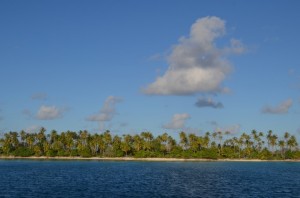
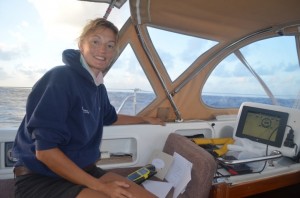
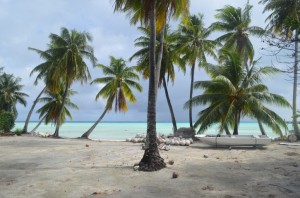
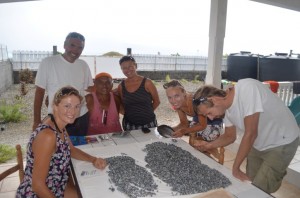
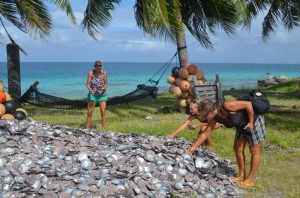
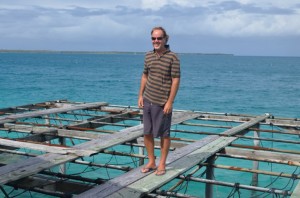
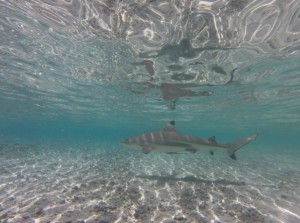
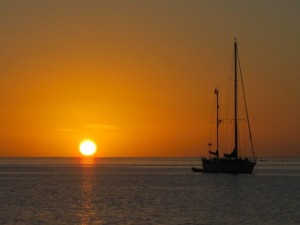
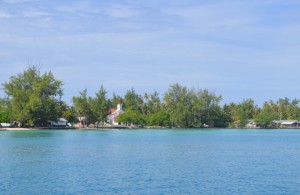
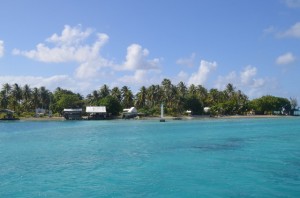
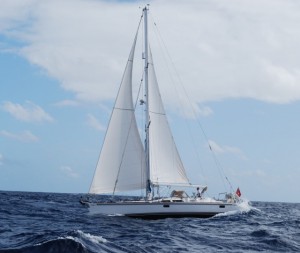
I find your blogs fascinating to read. Please keep them coming.
This blog will make a great book! Keep up the good work.
Life is a beach!!
The weather in NZ has been a lot, lot wilder and colder than you’ve been enjoyingand the Soloman Islands have been washed out to sea.
So relatively speaking, you’re in a nice cosy spot. Enjoy!!
….oh, and I promise not to mention the rugby, or the football or the cricket……